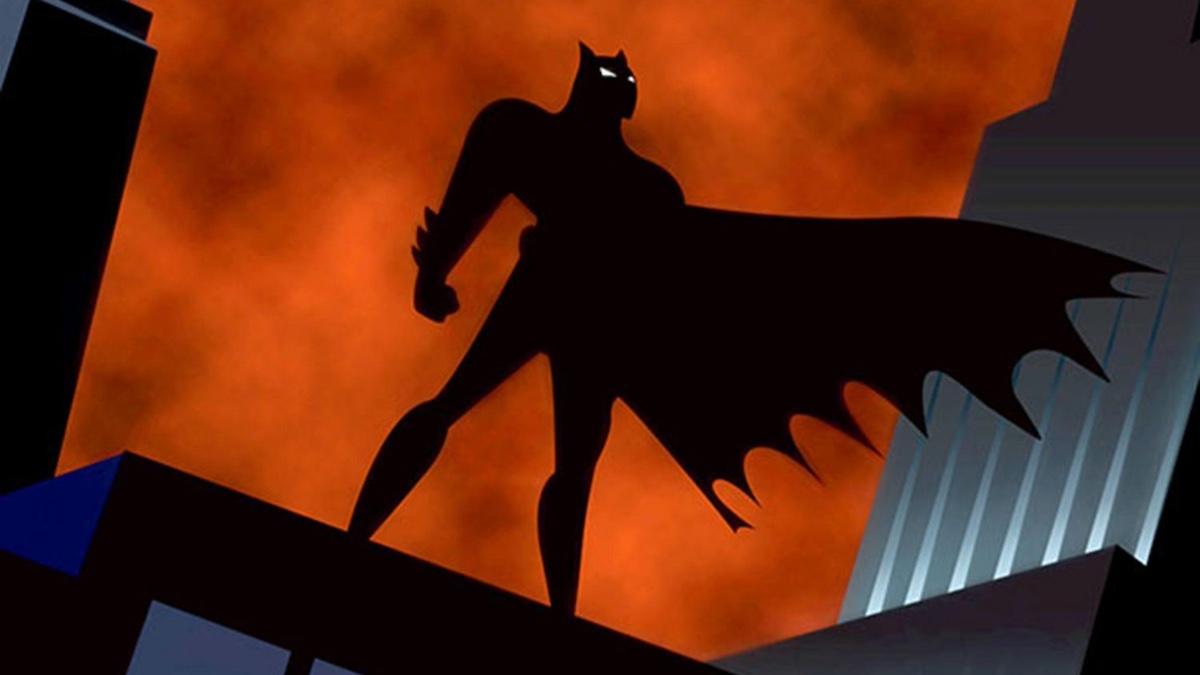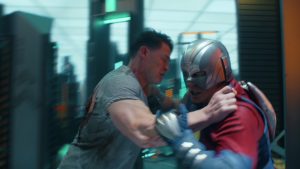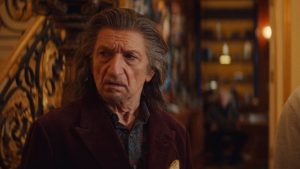
Looking back, the early nineties were the best of times and worst of times for Batman fans. In 1989, fans got their first big-budget Hollywood Batman movie, followed by the 1992 sequel Batman Returns. Both of these films boasted A-list talent and made huge money. But they weren’t really interested in Batman, at least not the guy that comic book readers loved.
But 1992 saw the launch of Batman: The Animated Series, a cartoon that gave fans some of the best ever tales of the Dark Knight, in any media. Created by Bruce Timm and Eric Radomski, The Animated Series took some visual cues from Burton’s movies, especially in its designs for Catwoman and the Penguin, but it was grounded in the Bronze Age comics by Dennis O’Neil and Neal Adams as well as 1940s cinema.
Taking a lead from the Fleischer Brothers’ Superman cartoons, Timm and Radomski insisted upon smooth animation for their project, giving the works a timeless feel. Combined with the full scores composed by Shirley Walker and Andrea Romano’s excellent voice casting, resulting in Kevin Conroy and Mark Hamill becoming the ideal Batman and Joker, Batman: The Animated Series stands as the definitive collection of Batman stories.
Sixty-five episodes released across 1992 and 1993, followed by an additional twenty released in 1994 and 1995 under the title The Adventures of Batman & Robin, until the show rebooted into the less successful (but not entirely without merit) The New Batman Adventures. This list looks at the greatest entries of Batman: The Animated Series and The Adventures of Batman & Robin, the 15 tales that continue to stand among the best of the best.
Photo: Warner Bros. Animation.
15. “Eternal Youth”
Season 1 Episode 16
Batman: The Animated Series was dark, sure, but it was still a children’s program designed for Fox Kids. So the series had to be judicious when trying to show the stakes of its villains’ actions. And like the 1930s and ’40s movies that inspired so much of Batman: TAS, the suggestion of violence made things much scarier than actual depictions.
The Poison Ivy episode “Eternal Youth” proves this point. Written by Beth Bornstein and directed by Kevin Altieri, “Eternal Youth” finds Bruce Wayne getting an invitation to the Eternal Youth Spa. Too busy dealing with the fallout with his company’s partial destruction of an Amazon rainforest (unauthorized by Bruce, of course; he is an ethical capitalist, apparently), Bruce sends Alfred and his lady friend Maggie instead. There, they get caught in a plot by Poison Ivy, which transforms rich people into plants and trees. So shocking is the idea of human changing into trees, at least for the show’s intended audience, that viewers almost forget that Ivy’s plan might actually be a good thing.
Photo: Warner Bros. Animation.
14. “Christmas With the Joker”
Season 1 Episode 2
Here’s a pop culture truism, whether we want to face it or not. Everything gets a charge from the inclusion of the Joker. Yes, he’s overused, and yes, he’s tiresome. But he’s overused and tiresome because the presence of the Clown Prince of Crime immediately adds energy to the proceedings. Case in point, “Christmas With the Joker,” a fairly straightforward holiday episode that works because it lets the Joker run amok during the holidays.
“Christmas With the Joker” begins with the Joker singing “Jingle-Bells, Batman Smells” as he escapes Arkham Asylum and ends with Bruce and Dick, the Robin of the series, sitting down to enjoy It’s a Wonderful Life. In between, the Joker subjects the Dynamic Duo to all manner of Yuletide chaos. “Christmas With the Joker” isn’t the most groundbreaking episode of all time, but writer Eddie Gorodetsky and director Kent Butterworth provide a solid slice of fun, of the type that only the Joker can provide.
Photo: Warner Bros. Animation.
13. “A Bullet for Bullock”
Season 4 Episode 4
Batman: The Animated Series started out with a bang, but diminished in quality by the time it became The Adventures of Batman & Robin. Although not as extreme as the shift to The New Adventures of Batman, the show became less timeless and more a standard ’90s cartoon show. “A Bullet for Bullock” briefly returns the show to its former glory by drawing from the noir roots that inspired it and focusing on the grouchy Detective Harvey Bullock, voiced by character actor Robert Costanzo.
A mainstay since the beginning of the series, Bullock often butted heads with Batman, resenting the vigilante for doing the job of the police. But in “A Bullet for Bullock,” written by Michael Reaves and directed by Frank Paur, Bullock has to turn to his rival for help. When crime boss Vinnie the Shark gets back onto the street, he comes looking for Bullock, forcing the Detective to enlist Batman for help. Although it could be seen as a rejoinder against Bullock’s pig-headedness, “A Bullet for Bullock” in fact reveals the Detective to be a decent man underneath his uncouth demeanor.
Photo: Warner Bros. Animation.
12. “Two-Face” Part 1 and 2
Season 1 Episodes 17 and 18
Bill Finger and other early Batman comic book writers paved the way for the psychologically-complex villains that have become standard practice in popular culture. TAS followed suit with sympathetic takes on the rogue’s gallery, including one of his best baddies, Two-Face. An appropriately two-part episode, “Two-Face” traces the fall of Bruce’s old pal Harvey Dent (Richard Moll), a district attorney whose fragile mind snaps when a gangster attack scars him.
Writer Alan Burnett and director Kevin Altieri lean into the tragedy of Dent’s situation, a man who wants to fight back against crime boss Rupert Thorne (John Vernon), but finds the law unsuited to the task. Best of all, “Two-Face” serves as a referendum on Batman himself, showing the potential cost of his war on crime. As such, it features some of Conroy’s best voice work as Bruce, fleshing out an oft-ignored aspect of the character.
Photo: Warner Bros. Animation.
11. “The Clock King”
Season 1 Episode 14
Unless you were a fan of the comedic Justice League International by Keith Giffen, J.M. DeMatteis, and Kevin Maguire, you likely weren’t aware of the Clock King before he got the title role in the 1992 episode “The Clock King.” Then again, the TAS version of the story offers a very different take on the character than any of the comics. Instead of a lunatic obsessed with clocks, this version of the Clock King is a precise taskmaster who pushes the Dark Knight to his limits.
Like its central character, “The Clock King” unfolds with perfect timing, a tightly-wound clock of a plot. Years after current Gotham Mayor ruined his company, businessman Temple Fugate takes the moniker the Clock King and enacts his revenge. Writer David Wise and director Kevin Altieri keep Batman behind schedule for most of the story, which gives him the opportunity to stretch his detective muscles. When Batman disrupts the Clock King at the last minute, it’s a victory of mind, not muscle.
Photo: Warner Bros. Animation.
10. “Harley and Ivy”
Season 1 Episode 47
Within the world of the 1940s that inspired The Animated Series, a subservient moll made sense, and thus Harley Quinn fit well within the show as an abused girlfriend of a violent crime boss. However, when Harley made the jump into the rest of popular culture, the unpleasant qualities stood out more. Recent takes, such as Tom Taylor’s writing on Injustice and the movie Birds of Prey, Or the Fantabulous Emancipation of One Harley Quinn, have moved Harley out of the Joker’s shadow.
However, these other writers could have saved themselves a lot of trouble if they would have just cut to the chase and adapted “Harley and Ivy,” written by Harley’s co-creator Paul Dini and directed by Boyd Kirkland. The episode begins with Harley getting shoved out of the hideout after talking back to Joker, and falling in with Poison Ivy. Thanks to their immediate chemistry, Harley and Ivy became fan favorites from the beginning, made all the sweeter by the chauvinists they take down on their rampage. Sure, “Harley and Ivy” has Harley longing to return to the Joker, but those are first steps that other media took far too long to continue.
Photo: Warner Bros. Animation.
9. “Nothing to Fear”
Season 1 Episode 10
Part of the appeal to Batman’s rouges gallery stems from the fact that so many could claim the title of archenemy. Two-Face mirrors Bruce’s shift from society boy to avenger, Ra’s al Ghul challenges the intellect of the World’s Greatest Detective, and there’s of course the Joker. The Animated Series made a case for the Scarecrow as the evil shadow to Batman, starting with “Nothing to Fear.”
Writers Henry T. Gilroy and Sean Catherine Derek and director Boyd Kirkland present the Scarecrow as a villain who strikes at the heart of Batman’s hidden weaknesses. What begins as a simple investigation into attacks on Gotham University students results in a crisis of faith when Batman gets a dose of Scarecrow’s fear toxin. The episode tears down Batman only to let him unleash one of the best lines in the character’s history: “I am the night! I am vengeance! I am Batman!”
Photo: Warner Bros. Animation.
8. “The Man Who Killed Batman” (Episode 49)
Season 1 Episode 49
Bruce Timm, Paul Dini, and other creatives behind TAS cite the great Will Eisner and his The Spirit comics as a key influence. Nowhere is that more clear than in “The Man Who Killed Batman,” written by Dini and directed Timm. “The Man Who Killed Batman” features a two-bit goon appropriately named Sidney Debris, whose bumbling mistake resulted in Batman’s apparent death.
Like some of the best Eisner Spirit stories, “The Man Who Killed Batman” puts the titular hero way in the background to follow a normal person. This shift in perspective allows the viewer to see the protagonist’s effect on the larger city. But it also builds sympathy for the type of guy who usually gets unceremoniously knocked out in a battle between heroes and villains, enriching the world overall.
Photo: Warner Bros. Animation.
7. “Appointment in Crime Alley”
Season 1 Episode 12
Some might gripe that Batman’s origin has become cliche and unnecessary. How many times do we need to see Martha’s pearls fall to the ground or Thomas facing down Joe Chill? But there’s no question that Bruce’s founding trauma hangs over every Batman story, even those that try to tell standard superhero tales. The challenge of writing Batman, then, involves acknowledging his parent’s death without falling back on obvious imagery.
Leave it to legendary comic book writer Gerry Conway to get it right in his script for “Appointment in Crime Alley,” directed by Boyd Kirkland. “Appointment in Crime Alley” follows Batman as he tries to make it back to Crime Alley to acknowledge the anniversary of his parents’ death, delayed by mobster Dagget and other baddies. The episode not only brings comic book character Dr. Leslie Thompkins (sorry to mention her, Spoiler fans) into the show, allowing her to offer Bruce a modicum of healing.
Photo: Warner Bros. Animation.
6. “The Last Laugh”
Season 1 Episode 15
Mark Hamill’s Joker is so consistently great and the Joker’s appearances on TAS are so perfectly handled that it’s hard to pick the best episode featuring the Clown Prince of Crime. “The Last Laugh,” directed by Kevin Altieri and written by Carl Swenson, gets the nod not so much because it’s a great Joker episode (even though it is) but because it’s a great, great Alfred episode.
The A-plot involves the Joker celebrating April Fool’s Day by poisoning all of Gotham City with his laughing gas, but the B-plot involves Alfred taking notice of Bruce’s exhaustion. Voiced by Efrem Zimbalist Jr. (who took over from Clive Revill, who played the character in the first three episodes), Alfred was the perfect mixture of droll English butler and Batman’s greatest partner. Nothing captures the importance of Alfred better than when he notices that Bruce cut himself shaving and tries to cheer up his ward with an ill-received April Fool’s Day joke. That moment reminded everyone that no one cares for Bruce like Alfred.
Photo: Warner Bros. Animation.
5. “Robin’s Reckoning,” Part 1 and 2
Season 1 Episodes 51 and 53
Of course, Batman’s other great partner is Robin the Boy Wonder. Until it took on the name The Adventures of Batman & Robin, TAS acknowledged the importance of Robin, in his Dick Grayson form until getting replaced by (the ill-fated) Tim Drake in The New Adventures of Batman, but used him sparingly. But when they did turn their attention to Robin, the show did some of its best work, as in the Emmy Award winning two-parter “Robin’s Reckoning,” written by Randy Rogel and directed by Dick Sebast.
The two-parter threads flashbacks of Robin’s childhood as a member of the acrobatic group the Flying Graysons with his discovery as an adult of the whereabouts of Tony Zucco, the man who killed his family. The storyline adds perspective to Batman’s tale by refracting it through Robin, drawing a distinction between the angry thirst for vengeance and an empathetic desire for justice, securing Batman’s position as one of the greatest superheroes.
Photo: Warner Bros. Animation.
4. “Baby-Doll”
Season 3 Episode 4
Hack Batman writers treat the Dark Knight as nothing more than an always-prepared grouch who resents everyone else for not being him. They look at the gothic imagery of the O’Neill and Adams run or Steve Englehart and Marshall Rogers era and assume he’s all solitary brooding, not bothering to pay attention to the humanism in those scripts. Director Dan Riba and writer Dini emphasize that compassionate quality by introducing an all-new character in “Baby-Doll.”
“Baby-Doll” features former child star Mary Dahl, whose child-like looks have stalled her career and driven her mad. That set-up suggests another classic Batman villain, a person whose physical appearance makes them into a baddie. And, to be sure, “Baby-Doll” does hold to that format for most of its running time, in which Dahl unleashes pint-sized terror. But there’s the end of the story, in which Batman has stopped Dahl and she breaks down, confused and horrified about her life. Overcome by sorrow, Dahl grasps Batman’s leg and, instead of growling at her about justice or vengeance, he just rests his hand on her head.
Photo: Warner Bros. Animation.
3. “Beware the Gray Ghost”
Season 1 Episode 32
For self-serious, pretentious kids watching the show in the ’90s (read: me), Batman: The Animated Series represented a rejection of the 1960s Batman, with its utter disrespect for the form. Then “Beware the Gray Ghost” happened, in which my favorite Batman paid homage to my least favorite Batman, Adam West.
West voices Simon Trent, an aged television star who once portrayed the trench coat and fedora-wearing hero the Gray Ghost. While investigating a series of remote-controlled bombings, Batman realizes that the perpetrator is copying an episode of The Gray Ghost, Bruce’s favorite tv show as a child. When writers Garin Wolf and Tom Ruegger, working from a story by Dennis O’Flaherty and Ruegger, and director Boyd Kirkland have Batman express his admiration and gratitude for Trent’s work as the Gray Ghost, one also senses Conroy and everyone else behind the series do the same, showing love that even an edgy doofus like me could understand.
Photo: Warner Bros. Animation.
2. “Almost Got ‘Im”
Season 1 Episode 35
Even thought it doesn’t wallow in the same misery as the worst Batman stories, TAS stayed fairly moody, making full-on comedy unlikely. And yet, “Almost Got ‘Im” by Dini and Radomski manages to tell a very funny story without breaking the show’s tone. Like “The Man Who Killed Batman,” “Almost Got ‘Im” keeps the hero in the background, instead focusing on a quintet of villains — Penguin, Killer Croc, Poison Ivy, Two-Face, and the Joker — playing cards and swapping their stories about nearly catching Batman.
The format gives Dini and Radomski the opportunity to bring in some classic Batman bits, including Two-Face tying the Caped Crusader to a giant coin. But the real appeal is the chummy camaraderie between the baddies, who get a chance to blow off steam and swap stories, such as Killer Croc’s reoccurring plot to throw a “big rock” at his enemy. The episode even ends with one of Catwoman’s rare memorable moments in the series, making it a funny celebration of the Bat-Villains.
Photo: Warner Bros. Animation.
1. “Heart of Ice”
Season 1 Episode 14
Of course, “Heart of Ice” tops this list, a shockingly moving story about a tragedy that drives someone to become a villain. The episode came from the dream team of Dini and Timm and won the series its first Emmy Award. Moreover, it completely revamped one of the dumbest characters in Batman’s rogues gallery, a low-rent Captain Cold knock off whose only notable appearances were in the 1966 Batman series, where three different actors played him.
“Heart of Ice” deserves all of these accolades and more. Michael Ansara gives his heartbroken scientist Victor Fries the right mixture of resignation and unending hurt, making his decision to strap on a glass helmet and shoot people with an ice gun seem like the most logical thing in the world. But the best part might be Conroy’s line reading after learning about Fries’s tragic back story. With the two words “My God,” Conroy reminds viewers of the deep humanity that drives Batman, a man who knows the pain of tragedy and ultimately sympathizes with even an outrageous villain like Mr. Freeze.
The post Batman: The Animated Series – The 15 Best Episodes appeared first on Den of Geek.






